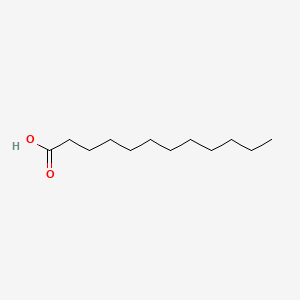| MeSH term | MeSH ID | Detail |
|---|---|---|
| Hemolysis | D006461 | 131 associated lipids |
| Neovascularization, Pathologic | D009389 | 39 associated lipids |
| Lung Neoplasms | D008175 | 171 associated lipids |
| Colonic Neoplasms | D003110 | 161 associated lipids |
| Diabetes Mellitus, Experimental | D003921 | 85 associated lipids |
| Body Weight | D001835 | 333 associated lipids |
| Acne Vulgaris | D000152 | 35 associated lipids |
| Hypersensitivity, Delayed | D006968 | 43 associated lipids |
| Liver Neoplasms, Experimental | D008114 | 46 associated lipids |
| Thrombosis | D013927 | 49 associated lipids |
lauric acid
lauric acid is a lipid of Fatty Acyls (FA) class. Lauric acid is associated with abnormalities such as Infection, Renal tubular disorder, Hypertensive disease, Obesity and Mycoses. The involved functions are known as Transcription, Genetic, Signal Transduction, Mutation, metaplastic cell transformation and Anabolism. Lauric acid often locates in Skin, Plasma membrane, Cytoplasmic matrix, Body tissue and Palmar surface. The associated genes with lauric acid are Gene Family, SLC33A1 gene, Homologous Gene, Open Reading Frames and P4HTM gene. The related lipids are Fatty Acids, Oleic Acids, Palmitates, Stearates and 9,11-linoleic acid.
Cross Reference
Introduction
To understand associated biological information of lauric acid, we collected biological information of abnormalities, associated pathways, cellular/molecular locations, biological functions, related genes/proteins, lipids and common seen animal/experimental models with organized paragraphs from literatures.
What diseases are associated with lauric acid?
lauric acid is suspected in Renal tubular disorder, Hypertensive disease, Infection, Renal vascular disorder, Obesity, Mycoses and other diseases in descending order of the highest number of associated sentences.
Related references are mostly published in these journals:
| Disease | Cross reference | Weighted score | Related literature |
|---|
Possible diseases from mapped MeSH terms on references
We collected disease MeSH terms mapped to the references associated with lauric acid
PubChem Associated disorders and diseases
What pathways are associated with lauric acid
There are no associated biomedical information in the current reference collection.
PubChem Biomolecular Interactions and Pathways
Link to PubChem Biomolecular Interactions and PathwaysWhat cellular locations are associated with lauric acid?
Visualization in cellular structure
Associated locations are in red color. Not associated locations are in black.
Related references are published most in these journals:
| Location | Cross reference | Weighted score | Related literatures |
|---|
What functions are associated with lauric acid?
Related references are published most in these journals:
| Function | Cross reference | Weighted score | Related literatures |
|---|
What lipids are associated with lauric acid?
Related references are published most in these journals:
| Lipid concept | Cross reference | Weighted score | Related literatures |
|---|
What genes are associated with lauric acid?
Related references are published most in these journals:
| Gene | Cross reference | Weighted score | Related literatures |
|---|
What common seen animal models are associated with lauric acid?
There are no associated biomedical information in the current reference collection.
NCBI Entrez Crosslinks
All references with lauric acid
Download all related citations| Authors | Title | Published | Journal | PubMed Link |
|---|---|---|---|---|
| Temme EH et al. | Comparison of the effects of diets enriched in lauric, palmitic, or oleic acids on serum lipids and lipoproteins in healthy women and men. | 1996 | Am. J. Clin. Nutr. | pmid:8644684 |
| Voon PT et al. | Diets high in palmitic acid (16:0), lauric and myristic acids (12:0 + 14:0), or oleic acid (18:1) do not alter postprandial or fasting plasma homocysteine and inflammatory markers in healthy Malaysian adults. | 2011 | Am. J. Clin. Nutr. | pmid:22030224 |
| Lattka E et al. | Genetic variants in the FADS gene cluster are associated with arachidonic acid concentrations of human breast milk at 1.5 and 6 mo postpartum and influence the course of milk dodecanoic, tetracosenoic, and trans-9-octadecenoic acid concentrations over the duration of lactation. | 2011 | Am. J. Clin. Nutr. | pmid:21147856 |
| Grundy SM | Influence of stearic acid on cholesterol metabolism relative to other long-chain fatty acids. | 1994 | Am. J. Clin. Nutr. | pmid:7977157 |
| Robinson MK et al. | A two-center study of the development of acute irritation responses to fatty acids. | 1999 | Am. J. Contact Dermatitis | pmid:10444106 |
| Aponte GW et al. | Regional distribution and release of peptide YY with fatty acids of different chain length. | 1985 | Am. J. Physiol. | pmid:3841263 |
| Fink AS et al. | Regionally perfused fatty acids augment acid-induced canine pancreatic secretion. | 1983 | Am. J. Physiol. | pmid:6869548 |
| Meyer JH et al. | Length of intestinal contact on nutrient-driven satiety. | 1998 | Am. J. Physiol. | pmid:9756564 |
| BISCHOFF F | The influence of sodium lauryl sulfate on the biologic response to the gonadotropins and to insulin. | 1945 | Am. J. Physiol. | pmid:21009247 |
| Hommelberg PP et al. | Fatty acid-induced NF-kappaB activation and insulin resistance in skeletal muscle are chain length dependent. | 2009 | Am. J. Physiol. Endocrinol. Metab. | pmid:18957619 |
